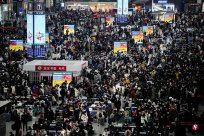Early North to read
The world's longest cross -sea bridge and a 55 -kilometer -long Hong Kong -Zhuhai -Macao Bridge have officially opened to traffic this week.This huge project that costs 120 billion yuan (RMB, the same, the same, 24 billion yuan) will accelerate the integration of Guangdong, Hong Kong, Macao, and Zhuhai, one of the earliest special economic zones of China, which will be brought back againIn the sight.
On August 26, 1980, the Chinese leadership that bid farewell to the Cultural Revolution was not too long, and made a major decision: the whole country approved the settlement of special economic zones in Shenzhen, Zhuhai, Shantou and Fujian Province in Guangdong Province.The two special economic zones of Shenzhen and Zhuhai were officially established on the same day. The construction location and scope of the Xiamen Special Economic Zone were approved by the State Council on October 7 of the same year, and Shantou was established on October 16 of the following year.
Although Shenzhen, Zhuhai, Xiamen, and Shantou are the first batch of special zones after reform and opening up. Shenzhen and Zhuhai can even be said to be the same day, but everyone's starting point is different from the life.First of all, the area of the Shenzhen Special Economic Zone was 327.5 square kilometers, but Zhuhai was only 6.8 square kilometers. Xiamen and Shantou were smaller, with only 2.5 square kilometers and 1.67 square kilometers, respectively.Although the Zhuhai Special Economic Zone expanded to 121 square kilometers in 1988, the Xiamen Special Economic Zone expanded to 131 square kilometers in 1984, but it was less than half of the area of Shenzhen Special Economic Zone.
The political status of the four cities is also different. Shenzhen became a deputy provincial -level city in 1981. In 1994, Xiamen was only prefecture -level cities in Zhuhai and Shantou.
What's more, Shenzhen has a huge pressure and advantage separately from Hong Kong, which allows this city to accumulate a strong cause and impulse to break through the old system and the frame of the old system and the outside world.EssenceIn fact, as early as 1980, before the third Plenary Session of the Eleventh Central Committee of the Cultural Revolution in December 1978, high -level reformers had thought of creating a test area for opening to the outside world in Shenzhen (then Baoan County).
In October 1978, 61 -year -old Yuan Geng was sent to Hong Kong to host the China Merchants Bureau. After inspecting Hong Kong, Yuan Geng reported to the Ministry of Communications and the State Council to build the first nationwide nationwide in the country in Baoan County, Guangdong, from the end of that year to January 1979.Request to the export processing area.On July 20, 1979, the Shekou Industrial Zone was officially launched.
At the same time, Xi Zhongxun, who had just returned to politics, was sent to Guangdong in April 1978 to serve as the second secretary and first secretary of the Guangdong Provincial Party Committee of the Communist Party of China.Historical sources showed that Guangdong was a climax of escape from the time. When Xi Zhongxun arrived for the first time, he went to the county and city for the first time to inspect, and he went to Baoan County, where the smuggling situation was the worst.Since the 1950s, the fugitives have reached 40,598, accounting for about 30 % of the county's total labor force. All three villages have escaped, and the land has been lost, and the people's hearts are not stable.
In order to narrow the gap with Hong Kong and develop productivity, Xi Zhongxun asked to decentralize power to Guangdong when he went to Beijing in April 1979. So there was a wide spread of Deng Xiaoping.Kill a bloody road.
The above -mentioned various realistic pressures and the courage to dare to involve danger in danger and not be afraid of personal safety at that time opened a situation for the establishment of the Special Economic Zone in Shenzhen in 1980.The Shenzhen Special Administrative Region has developed a unique show. Many historians and old Shenzhen citizens have not forgotten the first mayor Liang Xiang with a fame, leading Shenzhen to create a miracle historical contribution.
In 2017, the GDP of Shenzhen reached 2.2 trillion yuan. Not only did they catch up with the criminal destinations of the Baoan County citizens that year, they also left Xiamen's 435.1 billion yuan in the back.In contrast, Zhuhai and Shantou, with only about 250 billion yuan of GDP, are even more sad.
Shenzhen, which had previously traveled from 1998 to 2004, and Shenzhen, which has become a concentrated place for China Wind Investment Funds and high -tech industries, and is the youngest first -tier city, the prospects are still shining.
What factors constitute the success of Shenzhen?People can analyze many reasons: special geographical conditions near Hong Kong, local officials, central government support, accurate positioning, innovative DNA, immigration culture, etc.It is also believed that there is only one secret of Shenzhen's success, that is, adjacent to Hong Kong and the absorption of Hong Kong's openness and market economy. The government avoids excessively direct intervention in the development of the industry and enterprises, maintaining a distance from the market, but creating a regular environment.
Shenzhen's geographical advantages cannot be copied, but its success elements can be learned by other cities.At the time of the 40th anniversary of reform and opening up, China has faced the new situation and new challenges in the international and domestic situation. High -levels have repeatedly emphasized that they will overcome their current difficulties by adhering to reform and opening up.But what is reform and opening up?Looking back at the experience of the past 40 years, the core essentials are marketization and rule of law, reducing government intervention. After a clear direction, no matter how much confidence is, it is not as good as a few real moves. Only in this way can we implement the reform goals.


